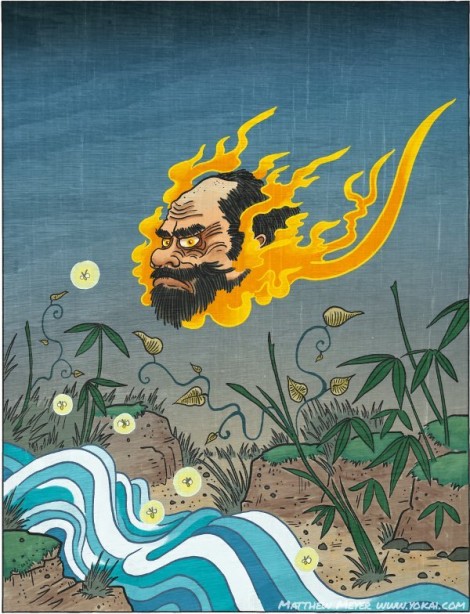Today’s yokai is a fairly obscure one, and he is a type of hi-no-tama, or fireball yokai.
Sōgen-bi (叢原火 or 宗源火, そうげんび)
Sōgen-bi, literally “Sōgen’s fire” is a yokai that was sighted at Mibu-dera in Kyoto. (Mibu-dera is also very famous for being the home of the legendary Shinsengumi.) This yokai takes the form of a flying, burning priest’s head, suffering in agony.
Legend has it that long ago, a monk named Sōgen lived at Mibu-dera. Sōgen was a wicked monk, for he would steal money out of the offering box at the temple to keep for himself. He also stole the precious oil, which was to be used as an offering for the gods, and sold it off secretly, keeping the money for himself.
You’ll notice one recurring theme with yokai is lamp oil; cats who lick it turn into bakeneko, other yokai like rokuro-kubi and abura-akago like to drink it, people who steal oil die and turn into yokai like abura-sumashi, ubaga-bi, or something like wicked old Sōgen. This seems kind of strange to us today, with our electric lights, where candles are a quaint thing for entertainment (“We will make Electric Light so cheap that only the rich will afford to burn candles.” – Thomas Edison); but in old Japan oil was particularly precious. It could be acquired from fish or whales or by wringing leaves of certain plants, but no matter where it came from it took a lot of hard work to make lamp oil for burning. It was one of the most precious commodities, as hard to believe as it is today! Therefore, stealing something as valuable as oil was viewed as a particularly heinous crime, and these wicked people would have to pay the price in their next life.
Thus was the punishment for Sōgen. When he died, he was damned to hell and reincarnated as this yokai. Toriyama Sekien listed him in his Gazu Hyakki Yagyō yokai manual, and similar burning-head oil-thief yokai types have been recorded in other books.
There is somewhat of a moral to this story: don’t steal from your workplace. I know some of you have probably nicked a roll of toilet paper, or a stapler, or a notepad or something, haven’t you? Just be careful that when you die you don’t come back like old Sōgen did!

If you’d like to read more about Sōgen-bi, head on over to yokai.com.
If you like this yokai and want to learn more about Japanese monsters, check out my book or join my Kickstarter project to become a part of my next book! |
Sōgen-bi (叢原火 or 宗源火, そうげんび)
叢原火(宗源火)は京都の壬生寺に現れる妖怪である。(壬生寺は新撰組の屯所としても有名な場所。)この妖怪は、炎の中に苦悶の表情を浮かべた坊主の頭が浮かんで浮遊しているというものである。
かつて、宗源という僧侶が壬生寺の賽銭箱から賽銭や油を盗んでいた事に由来している。叢原火(宗源火)は、その報いとして宗源が鬼火にされてしまった姿だとされているのだ。
灯油(油)にまつわる妖怪は他にもある。過去に紹介した″化け猫″(灯油の油を舐めて化け猫となった)や″ろくろ首″、″油赤子″など(灯油を好んで飲む)もその一つである。また油を盗んで妖怪と化したものでは、″油すまし″や″姥ヶ火″、そして、この悪行を働いた僧″宗源″がいる。
電気のある生活をしている今日(今やキャンドルは少し古臭く、また楽しみのためにだけ使われている)、私たちに取ってみるとやや不思議に思えるかもしれない(“We will make Electric Light so cheap that only the rich will afford to burn candles.” – Thomas Edison)。しかし、かつての日本では油はたいへん貴重なものであり、明かりを灯すために使われていた油は手に入れるのはなかなか難しかった。そのため、そのような大変貴重な油を盗むという行為は、来世で償いをしなくてはならないほどの重罪に値したのである。
これは宗源に対する罰であるといえる。死後、宗源は地獄で責めさいなまれた上にこの妖怪にされてしまったという。鳥山石燕はこの妖怪を「画図百鬼夜行」の中で紹介しれており、その他の油泥棒タイプの妖怪はほかの著書に掲載されている。
この話はモラルを説いているようでもありますね。仕事場の物を盗んではいけませんよ。トイレットペーパーやホッチキス、メモ用紙など、、、覚えはありませんか?
宗源の教訓を生かして気を付けるようにしましょう。もしかしたら来世ではこの世に戻ってこられないかもしれません・・・。

もしこの妖怪が気にいられて、もっと日本の妖怪について知りたいと思われましたら私の本もチェックしてみてください。そして、今開催中のKickstarter プロジェクトでの第2弾の本の出版へのご協力も是非お願いいたします!
